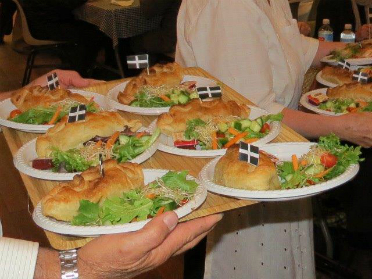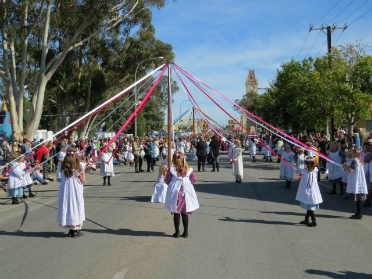1st June 2015
 Plenty of pasty and a good deal of excitement mark the Cornish Copper Coast on Yorke Peninsula in South Australia every second year at the Kernewek Lowender. Thirty five thousand visitors converge on Moonta, Kadina and Wallaroo to celebrate their Cornish roots and settlement in the early mining towns. Amid the heritage events and wide ranging commercial activities the festival programme lists a Spiritual Retreat sponsored by the Fellowship of St Piran-Australia and that in the past has been led by a number of Uniting Church ministers. The Retreat has now taken place over three festivals and has become a helpful illustration of how a planned Christian activity and presence can be incorporated as legitimate part of what is largely a secular festival. The focus has never been on attracting large numbers but on injecting something relevant of Christian content into a celebration where large numbers of people gather.
Plenty of pasty and a good deal of excitement mark the Cornish Copper Coast on Yorke Peninsula in South Australia every second year at the Kernewek Lowender. Thirty five thousand visitors converge on Moonta, Kadina and Wallaroo to celebrate their Cornish roots and settlement in the early mining towns. Amid the heritage events and wide ranging commercial activities the festival programme lists a Spiritual Retreat sponsored by the Fellowship of St Piran-Australia and that in the past has been led by a number of Uniting Church ministers. The Retreat has now taken place over three festivals and has become a helpful illustration of how a planned Christian activity and presence can be incorporated as legitimate part of what is largely a secular festival. The focus has never been on attracting large numbers but on injecting something relevant of Christian content into a celebration where large numbers of people gather. 
Held in the old Moonta Mines Uniting Church hall during the first two days of the festival the retreat provides an excellent reflective introduction to the rest of the week’s festivities. Co-ordinated by Rev Matt Curnow the official Kernewek Lowender programme described the Retreat as a two day prayer experience of listening to the story of the formative influences on the modern church in Cornwall in the setting when early Cornish settlers adapted their faith to the Australian landscape. In a diverse secular, multi-cultural world, celebrating the significance of our national Christian heritage without apology is of increasing importance. In fact to be in the market place doing this where the crowds gather is more than just important, it is increasingly a vital part of Christian mission that in many ways the church needs to relearn today.
This year the focus was on the Cornish saints and the spiritual development in Cornwall from the Reformation to the Wesleys. At the end of the period participants were invited to express their response to the Retreat in various forms. Three samples included the following.
Ian from Adelaide was captured by the concept of a new expression of Celtic monasticism. He drew a picture of his local church as a central community with its families and activities linked together in a way that was typical of the worship and practise of early Celtic monks, the way they served each other and the world.
Susan from New South Wales drew four boxes with different headings. All Celtic Saints, St Brendon the navigator, Martyrdom/ Polycarp of Smyrna, and then Wesley’s Travels. In the middle she placed a cross with the word “WHY?” Underneath she wrote, “For the love of their Lord.”
From Victoria Rev Ted Curnow created a verse around Wesley’s hymn:
My Chains-fast bound
Each link being part of me,
An extension of an stirring angst within.
My chain to self-desire, personal fulfilment, competition.
My chain to deceit, a falsehood in claim and practise.
My chain to duty, obligation, the expectation of others.
My chain to perform well, to attract and to win.
My chain to fear the unknown, a final judgement.
My chain to low self-esteem, heaviness weighed down.
My chains fell off.
And looking up I saw the Christ
lashed to a bloody cross,
fast bound by my heavy chains,
but no longer my own, my chains were His.
And looking down,
My heart was set free.
Enfolded by a presence not my own,
my new liberty was not my doing
earned or engineered.
An awesome gift of sacrifice,
a weight transferred, a conscience set free,
a life released, restored with pristine beauty.
An uncontainable life, full of His life, a residing love.
I rose went forth.
Not revived or renovated
but recreated a-new,
driven by a presence,
a grace-gift now resting within.
Ready, willing to flow, to wait, to follow
into the hard place, to embrace and endure.
Empowered by a freedom given.
The broken chains of the Christ had set me free.
(“My Chains fell off” MHB 371)
Rev E A Curnow.


Leave a comment